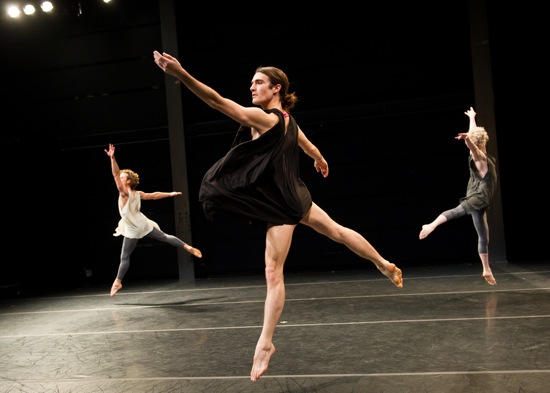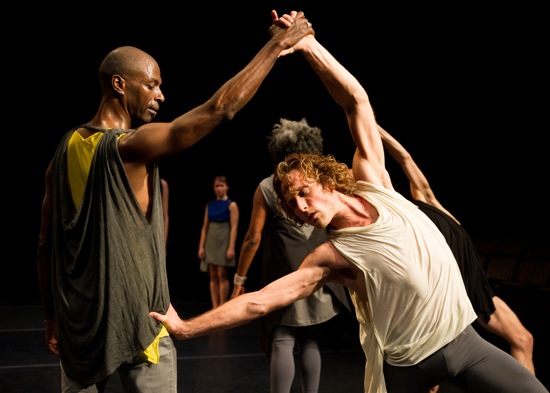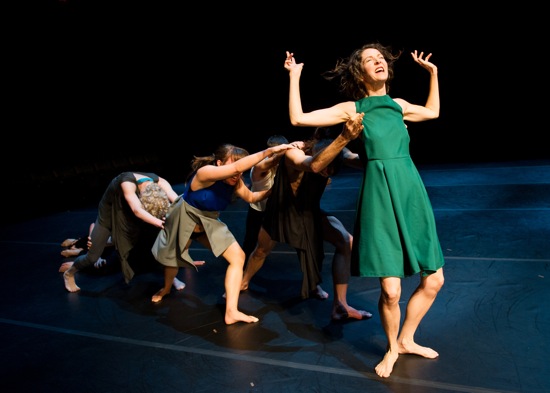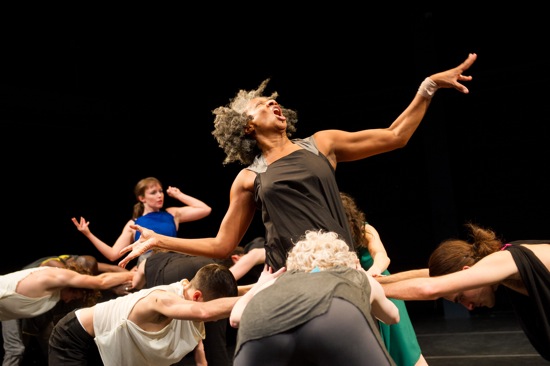Tere O’Connor’s Bleed, premiering on BAM’s Next Wave Festival, is built on the bones of three previous works.
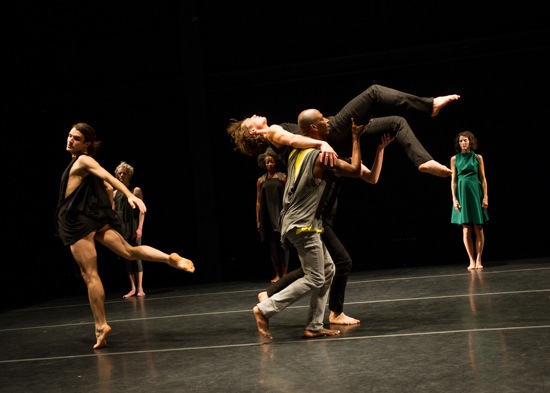
Tere O’Connor’s Bleed. Foreground (L to R): SIlas Riener, David Thomson carrying Michael Ingle. At back: Oisín Monaghan, Cynthia Oliver, Heather Olson. Photo: Ian Douglas
Writing about Tere O’Connor’s work is always a challenge (he himself does it very well). Watching his marvelous new Bleed in the Brooklyn Academy of Music’s Fishman Space is akin to recalling a night of dreaming. In it, as in dreams, events pour into one another, places morph into other places, non sequiturs succeed each other without a jolt. Bleed also takes some of its structural elements from our complicated daily lives, in which we often do one or more things while thinking about others—snapping beans, say, while listening to music and wondering what we might say in a letter we should have written long ago.
O’Connor doesn’t deal with stories or patch narrative elements together, although—and this is tricky—he allows for dance’s inevitable ability to convey human situations (since humans are its medium and human movements its material). The art form’s ambiguous and enigmatic nature entrances and challenges him. A sentence of Merce Cunningham’s comes to mind (I paraphrase): “A leap is not about man’s freedom. A leap is a leap. And it is man’s freedom.”
Bleed culminates a process that O’Connor embarked on two years ago. During this time span, he constructed and presented three works for three different casts. Secret Mary was danced by Tess Dworman, devynn emory, Ryan Kelly, and Mary Read. The cast of poem consisted of Natalie Green, Michael Ingle, Oisín Monaghan, Heather Olson, and Silas Riener. Cynthia Oliver and David Thomson performed Sister. All eleven appear in Bleed.
To create a fourth work with these exceptional performers, O’Connor collapsed (his word) his previous three pieces into the new hour-long one, but not by reconstructing, editing, and patching together. Instead, his process seems to have been one of remembering and forgetting, erasing and penciling anew, and weaving—or “bleeding”— strands from the first dances into one another to touch off new ideas.
In bringing Bleed into the world, O’Connor was aided by his highly individual and creative dancers, but also by Michael O’Connor’s elegant lighting and James Baker’s wonderfully variegated recorded score for cello, voice, and other instruments (Baker is a noted percussionist). Walter Dundervil has dressed the dancers in interestingly cut and draped outfits that emphasize their individuality. Only Olson wears an emerald green dress, for instance; only Riener wears black trunks and a loose-swinging, back-baring black top.
The choreography for Bleed mixes leaps and other steps that demand dancerly prowess with recognizable gestures that we may interpret how we please, plus a range of spatial, dynamic, and rhythmic contrasts that—often fleetingly—convey shifts in energy and states of mind. Olson’s opening solo introduces us to what we may expect. To muffled rhythmic sounds that suggest a train or some unidentifiable machine, she sashays around, her green skirt swinging. Tall and slim, she makes limp gestures as she goes, and her moves are as varied as putting a finger to the corner of her mouth, turning proficiently on one leg several times while leaving the other leg trailing behind, and making heavy, jerky, repetitive steps.
Yet everything she does flows together the way thoughts merge in the mind and incite new thoughts. What is consistent is the alertness of her gaze. She looks about her as if considering her possibilities and trying to understand alterations in the climate that surrounds her. As others join Bleed and leave it, cluster and scatter, collaborate and step aside, the shifting focus that Olson displayed turns out to be a vital part of the piece’s atmosphere. Everyone is aware of everyone else.
The way that O’Connor uses gesture or tableau— without follow-ups—gives them equal status with formal unison passages of dancing. They’re like those little dramas you pass by on the street (those encounters may have consequences, but you never know about them). Olson collapses four times, and each time Ingle, Kelly, Monaghan, and Riener help her up; she, recovered, gets them holding onto one another, then frees them; they take off—skittering and hustling along in a triplet rhythm, tracing mazy curves (when they dance, the passage of music with a medieval sound disappears, and male voices hum). Because of Bleed’s structural integrity, you don’t ask why; you make up stories (or not) and feel as if—on some much more mundane level—that this is your life.
Several times Monaghan lies supine, and M. O’Connor builds a sepulcher of light around him. Others stare down at him. He always recovers, even after Olson gasps, staggers, collapses, sits on him, and works his arms around. At one point several surround him like beasts with appetites. When he lies with his head where his feet were previously, you feel the momentousness of this more in terms of structural contrast than of meaning. In any case, “meaning” is porous. People open their mouths silently. Singing? Screaming? Or is the open mouth a gesture as abstract as an arabesque? Do we try to interpret the facial expressions we see when performers bend low and cluster around Oliver and Green, looking like big skirts around the two women? Maybe; maybe not. We can enjoy the respite in speed and design when various performers lounge rather languorously (like diners at Plato’s symposium) without pondering their motives.
The inventiveness and richness of what O’Connor has constructed is astonishing. Also how masterfully he has built Bleed to grow and change without anything seeming superfluous or excessive. There is so much fine dancing on view, so much beauty and strangeness to take in—and so much enigmatic yet familiar human behavior—that one viewing is hardly enough.

